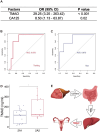High-throughput metabolomics identifies new biomarkers for cervical cancer
- PMID: 38551775
- PMCID: PMC10980666
- DOI: 10.1007/s12672-024-00948-8
High-throughput metabolomics identifies new biomarkers for cervical cancer
Abstract
Background: Cervical cancer (CC) is a danger to women's health, especially in many developing countries. Metabolomics can make the connection between genotypes and phenotypes. It provides a wide spectrum profile of biological processes under pathological or physiological conditions.
Method: In this study, we conducted plasma metabolomics of healthy volunteers and CC patients and integratively analyzed them with public CC tissue transcriptomics from Gene Expression Omnibus (GEO).
Result: Here, we screened out a panel of 5 metabolites to precisely distinguish CC patients from healthy volunteers. Furthermore, we utilized multi-omics approaches to explore patients with stage I-IIA1 and IIA2-IV4 CC and comprehensively analyzed the dysregulation of genes and metabolites in CC progression. We identified that plasma levels of trimethylamine N-oxide (TMAO) were associated with tumor size and regarded as a risk factor for CC. Moreover, we demonstrated that TMAO could promote HeLa cell proliferation in vitro. In this study, we delineated metabolic profiling in healthy volunteers and CC patients and revealed that TMAO was a potential biomarker to discriminate between I-IIA1 and IIA2-IV patients to indicate CC deterioration.
Conclusion: Our study identified a diagnostic model consisting of five metabolites in plasma that can effectively distinguish CC from healthy volunteers. Furthermore, we proposed that TMAO was associated with CC progression and might serve as a potential non-invasive biomarker to predict CC substage.
Impact: These findings provided evidence of the important role of metabolic molecules in the progression of cervical cancer disease, as well as their ability as potential biomarkers.
Keywords: Cervical cancer; Metabolites; Prognosis; Trimethylamine N-oxide.
© 2024. The Author(s).
Conflict of interest statement
The authors declare no potential competing interests.
Figures





Similar articles
-
Exploring the "gene-protein-metabolite" network of coronary heart disease with phlegm and blood stasis syndrome by integrated multi-omics strategy.Front Pharmacol. 2022 Nov 29;13:1022627. doi: 10.3389/fphar.2022.1022627. eCollection 2022. Front Pharmacol. 2022. PMID: 36523490 Free PMC article.
-
A Comprehensive Analysis of Metabolomics and Transcriptomics in Cervical Cancer.Sci Rep. 2017 Feb 22;7:43353. doi: 10.1038/srep43353. Sci Rep. 2017. PMID: 28225065 Free PMC article.
-
FAM83A as a Potential Biological Marker Is Regulated by miR-206 to Promote Cervical Cancer Progression Through PI3K/AKT/mTOR Pathway.Front Med (Lausanne). 2020 Dec 4;7:608441. doi: 10.3389/fmed.2020.608441. eCollection 2020. Front Med (Lausanne). 2020. PMID: 33344485 Free PMC article.
-
Exploration of biomarkers for the diagnosis, treatment and prognosis of cervical cancer: a review.Discov Oncol. 2022 Sep 24;13(1):91. doi: 10.1007/s12672-022-00551-9. Discov Oncol. 2022. PMID: 36152065 Free PMC article. Review.
-
Trimethylamine N-oxide (TMAO) as a New Potential Therapeutic Target for Insulin Resistance and Cancer.Curr Pharm Des. 2017;23(25):3699-3712. doi: 10.2174/1381612823666170622095324. Curr Pharm Des. 2017. PMID: 28641532 Review.
Cited by
-
Unlocking the Interactions Between the Whole-Body Microbiome and HPV Infection: A Literature Review.Pathogens. 2025 Mar 18;14(3):293. doi: 10.3390/pathogens14030293. Pathogens. 2025. PMID: 40137778 Free PMC article. Review.
-
The metabolic dialogue between intratumoural microbes and cancer: implications for immunotherapy.EBioMedicine. 2025 May;115:105708. doi: 10.1016/j.ebiom.2025.105708. Epub 2025 Apr 22. EBioMedicine. 2025. PMID: 40267755 Free PMC article. Review.
References
-
- What Are the Risk Factors for Cervical Cancer? [https://www.cdc.gov/cancer/cervical/basic_info/risk_factors.htm]
-
- Cervical Cancer Screening Every 5 Years OK. Cancer discovery 2018, 8(10):1204. - PubMed
-
- Fontham ETH, Wolf AMD, Church TR, Etzioni R, Flowers CR, Herzig A, Guerra CE, Oeffinger KC, Shih Y-CT, Walter LC, et al. Cervical cancer screening for individuals at average risk: 2020 guideline update from the American cancer society. CA A Cancer J Clin. 2020 doi: 10.3322/caac.21628. - DOI - PubMed
Grants and funding
- No. 21PJ085/Scientific Research Fund of Sichuan health and Health Committee
- 2022YFS0588/The Key Projects fund of Science & Technology Department of Sichuan Province
- 2022JDRC0069/The Key Projects fund of Science & Technology Department of Sichuan Province
- Q20073/Innovative Scientific Research Project of Medical Youth in Sichuan Province
- 2021CDDZ-26/the Dazhou-Sichuan University Intelligent Medical Laboratory in Dazhou
LinkOut - more resources
Full Text Sources
